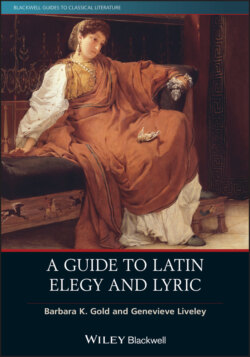Читать книгу A Guide to Latin Elegy and Lyric - Barbara K. Gold - Страница 8
Part II. How to Teach Latin Elegiac and Lyric Poetry
ОглавлениеGuiding students as they translate the Latin (and its literary figures) is only the beginning. Each genre, each author, each topic, and each poem will invite further analysis and study, raising questions about a wide range of difficult subjects: politics, poetics, gender, sexuality, religion, history, philosophy, ethics, and more. Elegy in particular introduces a number of “uncomfortable” subjects to the classroom, including: abortion, death, rape, and suicide. There is, as yet, no single book offering advice on “how to teach Latin lyric and/or elegy.” However, there is plenty of support and guidance available to help teachers negotiate these challenges and the following suggestions draw upon the wealth of advice collected by experienced teachers in various classroom contexts over the past few decades (see the “Guide to Further Reading” below). Clearly there is no single best approach to teaching Latin lyric and elegiac poetry, but these suggestions are a good starting point:
Get yourself a good “Companion” for the journey – The Cambridge Companion to Ovid, edited by Philip Hardie (2002); A Companion to Latin Literature, edited by Stephen Harrison (2006); A Companion to Catullus, edited by Marilyn Skinner (2007); The Cambridge Companion to Horace, edited by Stephen Harrison (2007); Stephen Heyworth’s Cynthia: A Companion to the Text of Propertius (2007a); A Companion to Ovid, edited by Peter Knox (2009); A Companion to Horace, edited by Gregson Davis (2010); A Companion to Roman Love Elegy, edited by Barbara Gold (2012); and The Cambridge Companion to Latin Love Elegy, edited by Thea Thorsen (2013).
Choose a “Reader” – Paul Allen Miller’s Latin Erotic Elegy: An Anthology and Reader (2002) stands out among the current library of textbooks available because it combines a judicious selection of Latin texts (including some pieces by Catullus and Sulpicia) together with textual commentaries and a critical anthology of the key pieces of secondary scholarship. Textbook style “Readers” of individual authors are also great teaching and learning resources. Try: Ronnie Ancona’s Passion: A Catullus Reader (2004); Paul Allen Miller’s, A Tibullus Reader (2013a); Phebe Bowditch’s, A Propertius Reader (2014); and Carole Newlands’, An Ovid Reader (2014).
Find a textbook or set of online resources that works for your needs and those of your students. There are hundreds of textbooks on the market and hundreds more sites online offering free texts, translations, commentaries, and study notes – both for students and teachers. These can vary widely in quality and disappear from servers so we do not offer any specific recommendations of online resources. However, the journal Classical World regularly publishes textbook reviews and surveys so is a good place to begin. Online teachers’ forums such as The Classics Library (https://www.theclassicslibrary.com) host an excellent array of teaching resources too.
Survey the wide range of critical reflections and essays written and published by experienced teachers of lyric and elegy, learn from their mistakes, and borrow their best ideas. The journal Classical World includes a useful section on pedagogy.
